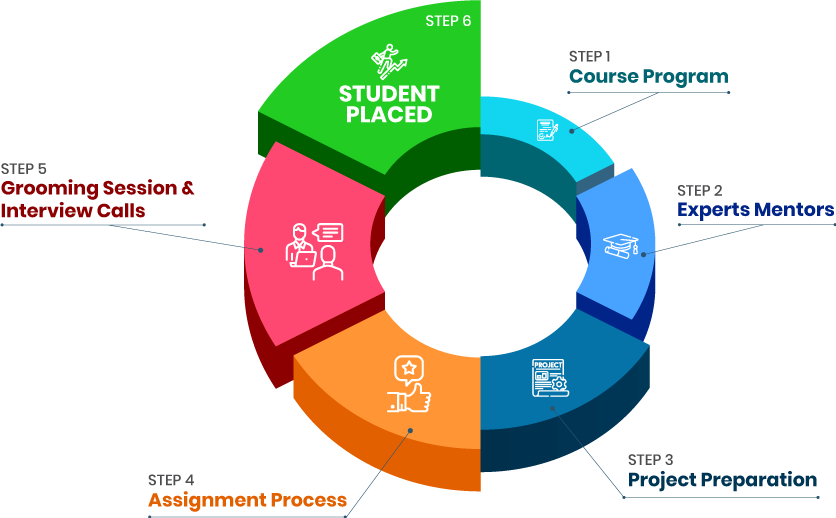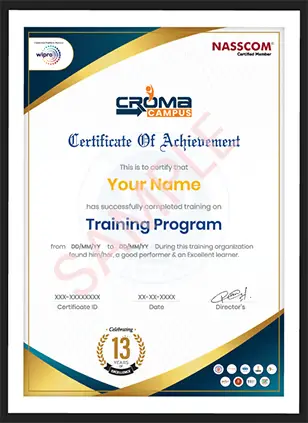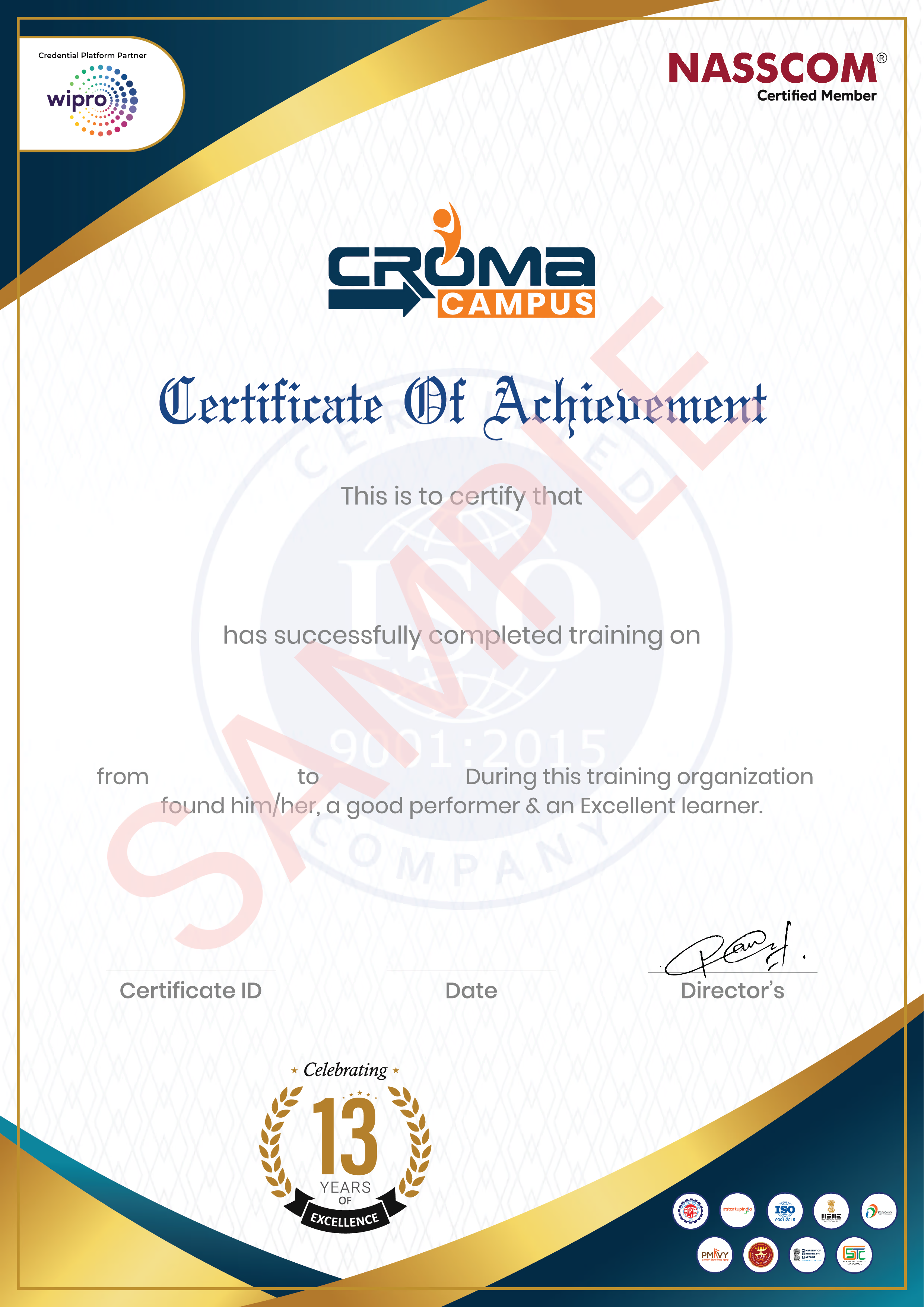- Are you fascinated by how machines can create text, images, and even music The Generative AI course in Canada will help you understand how artificial intelligence (AI) can generate creative content. Whether its creating realistic images or writing human-like text, you will learn how to build AI models that can do it all. Canada is known for its advanced tech industry, and AI is one of the most exciting fields right now. By completing this course, you will learn how to train AI systems that generate content, and you will be ready to work with cutting-edge AI technologies.
- Learn the Latest Technology: You will get to learn about cutting-edge AI tools like GANs (used for generating new images, videos, etc.) and other cool technologies that are shaping the future of AI.
- High Job Demand: Many industries (like entertainment, healthcare, and tech) need experts who can use Generative AI to create new content. After completing this course, you'll have plenty of job opportunities.
- Practical Hands-On Learning: The course includes projects where you will actually build AI models. You will work on creating things like AI-generated images and text, which will help you build a portfolio that employers will love.
- Learn from the Best: Canada is a global leader in AI, so you'll be learning from top instructors who are experts in the field. The skills you gain will be highly respected worldwide.
- Wide Career Opportunities: With the skills you gain, you can work in many different industries. Whether you want to work in media, healthcare, or technology, Generative AI skills are in demand everywhere.
- This Generative AI Training in Canada will teach you the essential skills needed to work with AI that can create new content. Heres what you will learn:
Basics of AI: Understand what AI is and how machine learning models work, especially the ones used for generating content.
Generative Models: Learn about the advanced AI techniques like GANs (Generative Adversarial Networks) and VAEs (Variational Autoencoders) used to create new content.
Deep Learning: Get a hands-on understanding of deep learning and how its used in generative AI models.
Text Generation with GPT: Learn how AI systems like GPT (Generative Pre-trained Transformers) can create human-like text and understand language.
Image Creation with GANs: Discover how GANs can generate images that look incredibly realistic, and learn how to train these models.
AI Ethics: Understand how to avoid biases and ensure that AI is being used ethically in your projects.
AI Tools: Learn to work with tools like TensorFlow, PyTorch, and Hugging Face to build your own AI systems.
- Starting Salary Range: C$104,000 per year. annually.
- In Indian Rupees: 64,392,000 (around 64.39 lakhs INR) per year.
- After completing the Generative AI course in Canada, you will have many career opportunities. Heres what to expect:
Entry-Level Jobs: Start as an AI Developer or Machine Learning Engineer, where you will help build and train AI models for text, images, or other creative tasks.
Mid-Level Roles: With some experience, you can become an AI Researcher, Generative AI Specialist, or AI Solutions Architect, where you will work on more complex AI systems.
Leadership Roles: After gaining experience, you could move into leadership roles like AI Product Manager or Director of AI Development, overseeing teams and projects.
- Generative AI is changing industries, and this course is growing in popularity. Heres why its so valuable:
AI Is the Future: AI is everywhere, from tech to healthcare. This course prepares you to work in one of the fastest-growing fields.
High Earning Potential: AI experts are in high demand and the salary potential is excellent.
International Recognition: A certification from Canada is recognized globally, giving you opportunities in Canada and beyond.
Versatility Across Industries: AI is used in many sectors like healthcare, entertainment, and e-commerce, so you will have a wide range of job opportunities.
- Here are some roles you can pursue after completing your Generative AI course in Canada:
AI Engineer: Work on developing and implementing AI models that generate creative content like images and text.
Machine Learning Engineer: Focus on creating algorithms that allow machines to learn from data and generate content.
Data Scientist: Use data to train AI models and help businesses make informed decisions.
Generative AI Researcher: Conduct research to improve existing AI models and explore new ways to use generative AI.
AI Product Manager: Oversee AI projects and help guide teams to create AI products that meet business needs.
- Generative AI is in demand across various sectors. Some of the top industries hiring AI talent include:
Tech & IT Companies: Tech firms need AI experts to improve their software, apps, and other products.
Healthcare: AI is used to develop personalized treatment plans and improve patient care.
Entertainment & Media: AI can help generate content like music, videos, and virtual reality experiences.
Finance & Banking: AI models are used to predict market trends, assess risks, and help with financial decision-making.
E-Commerce: AI is used for personalized recommendations, customer insights, and optimizing inventory.
- In this course, you will get practical experience with the following AI tools:
TensorFlow: A popular tool for building and training machine learning models.
PyTorch: A framework used for creating deep learning models.
Hugging Face: A platform for using pre-trained models for text generation and NLP tasks.
Keras: A simple and fast deep learning framework built on top of TensorFlow.
OpenAI GPT: Learn how to use GPT models for generating text and understanding language.
GANs: Understand how Generative Adversarial Networks are used to create realistic images and content.
- This course includes hands-on projects to help you gain real-world experience:
- These projects will help you build a strong portfolio that you can show to potential employers.
Text Generation Project: Train AI models to generate text that sounds like a human wrote it, such as for chatbots or automated content.
Image Generation Project: Work with GANs to create images, such as artwork or realistic photos.
Creative AI Project: Build an AI system that generates creative content like music, stories, or poems.
AI Chatbot Project: Develop a chatbot powered by AI that can answer questions and interact with users.
- Upon completion of the Generative AI Training in Canada, you will receive a certification that proves your skills and helps boost your career.
Why Should You Learn Generative AI?
By registering here, I agree to Croma Campus Terms & Conditions and Privacy Policy
 Course Duration
Course Duration
40 Hrs.
Flexible Batches For You
03-May-2025*
- Weekend
- SAT - SUN
- Mor | Aft | Eve - Slot
05-May-2025*
- Weekday
- MON - FRI
- Mor | Aft | Eve - Slot
30-Apr-2025*
- Weekday
- MON - FRI
- Mor | Aft | Eve - Slot
03-May-2025*
- Weekend
- SAT - SUN
- Mor | Aft | Eve - Slot
05-May-2025*
- Weekday
- MON - FRI
- Mor | Aft | Eve - Slot
30-Apr-2025*
- Weekday
- MON - FRI
- Mor | Aft | Eve - Slot
Course Price :
 1,320
1,320
 1,188 10 % OFF, Save
1,188 10 % OFF, Save
 1320
1320
Timings Doesn't Suit You ?
We can set up a batch at your convenient time.
Program Core Credentials
Trainer Profiles
Industry Experts
Trained Students
10000+
Success Ratio
100%
Corporate Training
For India & Abroad
Job Assistance
100%
Batch Request
FOR QUERIES, FEEDBACK OR ASSISTANCE
Contact Croma Campus Learner Support
Best of support with us
CURRICULUM & PROJECTS
Generative AI Course
- Installation and Working with Python
- Understanding Python variables
- Python basic Operators
- Understanding the Python blocks.
- Python Comments, Multiline Comments.
- Python Indentation
- Understating the concepts of Operators
- Arithmetic
- Relational
- Logical
- Assignment
- Membership
- Identity
- Variables, expression condition and function
- Global and Local Variables in Python
- Packing and Unpacking Arguments
- Type Casting in Python
- Byte objects vs. string in Python
- Variable Scope
- Declaring and using Numeric data types
- Using string data type and string operations
- Understanding Non-numeric data types
- Understanding the concept of Casting and Boolean.
- Strings
- List
- Tuples
- Dictionary
- Sets
- Statements if, else, elif
- How to use nested IF and Else in Python
- Loops
- Loops and Control Statements.
- Jumping Statements Break, Continue, pass
- Looping techniques in Python
- How to use Range function in Loop
- Programs for printing Patterns in Python
- How to use if and else with Loop
- Use of Switch Function in Loop
- Elegant way of Python Iteration
- Generator in Python
- How to use nested Loop in Python
- Use If and Else in for and While Loop
- Examples of Looping with Break and Continue Statement
- How to use IN or NOT IN keyword in Python Loop.
- What is List.
- List Creation
- List Length
- List Append
- List Insert
- List Remove
- List Append & Extend using + and Keyword
- List Delete
- List related Keyword in Python
- List Reverse
- List Sorting
- List having Multiple Reference
- String Split to create a List
- List Indexing
- List Slicing
- List count and Looping
- List Comprehension and Nested Comprehension
- What is Tuple
- Tuple Creation
- Accessing Elements in Tuple
- Changing a Tuple
- Tuple Deletion
- Tuple Count
- Tuple Index
- Tuple Membership
- TupleBuilt in Function (Length, Sort)
- Dict Creation
- Dict Access (Accessing Dict Values)
- Dict Get Method
- Dict Add or Modify Elements
- Dict Copy
- Dict From Keys.
- Dict Items
- Dict Keys (Updating, Removing and Iterating)
- Dict Values
- Dict Comprehension
- Default Dictionaries
- Ordered Dictionaries
- Looping Dictionaries
- Dict useful methods (Pop, Pop Item, Str , Update etc.)
- What is Set
- Set Creation
- Add element to a Set
- Remove elements from a Set
- PythonSet Operations
- Frozen Sets
- What is Set
- Set Creation
- Add element to a Set
- Remove elements from a Set
- PythonSet Operations
- Python Syntax
- Function Call
- Return Statement
- Arguments in a function Required, Default, Positional, Variable-length
- Write an Empty Function in Python pass statement.
- Lamda/ Anonymous Function
- *args and **kwargs
- Help function in Python
- Scope and Life Time of Variable in Python Function
- Nested Loop in Python Function
- Recursive Function and Its Advantage and Disadvantage
- Organizing python codes using functions
- Organizing python projects into modules
- Importing own module as well as external modules
- Understanding Packages
- Random functions in python
- Programming using functions, modules & external packages
- Map, Filter and Reduce function with Lambda Function
- More example of Python Function
- Creation and working of decorator
- Idea and practical example of generator, use of generator
- Concept and working of Iterator
- Python Errors and Built-in-Exceptions
- Exception handing Try, Except and Finally
- Catching Exceptions in Python
- Catching Specic Exception in Python
- Raising Exception
- Try and Finally
- Opening a File
- Python File Modes
- Closing File
- Writing to a File
- Reading from a File
- Renaming and Deleting Files in Python
- Python Directory and File Management
- List Directories and Files
- Making New Directory
- Changing Directory
- Threading, Multi-threading
- Memory management concept of python
- working of Multi tasking system
- Different os function with thread
- SQL Database connection using
- Creating and searching tables
- Reading and Storing cong information on database
- Programming using database connections
- Working With Excel
- Reading an excel le using Python
- Writing to an excel sheet using Python
- Python| Reading an excel le
- Python | Writing an excel le
- Adjusting Rows and Column using Python
- ArithmeticOperation in Excel le.
- Play with Workbook, Sheets and Cells in Excel using Python
- Creating and Removing Sheets
- Formatting the Excel File Data
- More example of Python Function
- Check Dirs. (exist or not)
- How to split path and extension
- How to get user prole detail
- Get the path of Desktop, Documents, Downloads etc.
- Handle the File System Organization using OS
- How to get any les and folders details using OS
- Statistics
- Categorical Data
- Numerical Data
- Mean
- Median
- Mode
- Outliers
- Range
- Interquartile range
- Correlation
- Standard Deviation
- Variance
- Box plot
- Pandas
- Read data from Excel File using Pandas More Plotting, Date Time Indexing and writing to les
- How to get record specic records Using Pandas Adding & Resetting Columns, Mapping with function
- Using the Excel File class to read multiple sheets More Mapping, Filling Nonvalues
- Exploring the Data Plotting, Correlations, and Histograms
- Getting statistical information about the data Analysis Concepts, Handle the None Values
- Reading les with no header and skipping records Cumulative Sums and Value Counts, Ranking etc
- Reading a subset of columns Data Maintenance, Adding/Removing Cols and Rows
- Applying formulas on the columns Basic Grouping, Concepts of Aggre gate Function
- Complete Understanding of Pivot Table Data Slicing using iLoc and Loc property (Setting Indices)
- Under sting the Properties of Pivot Table in Pandas Advanced Reading CSVs/HTML, Binning, Categorical Data
- Exporting the results to Excel Joins
- Python | Pandas Data Frame Inner Join
- Under sting the properties of Data Frame Left Join (Left Outer Join)
- Indexing and Selecting Data with Pandas Right Join (Right Outer Join)
- Pandas | Merging, Joining and Concatenating Full Join (Full Outer Join)
- Pandas | Find Missing Data and Fill and Drop NA Appending Data Frame and Data
- Pandas | How to Group Data How to apply Lambda / Function on Data Frame
- Other Very Useful concepts of Pandas in Python Data Time Property in Pandas (More and More)
- NumPy
- Introduction to NumPy Numerical Python
- Importing NumPy and Its Properties
- NumPy Arrays
- Creating an Array from a CSV
- Operations an Array from a CSV
- Operations with NumPy Arrays
- Two-Dimensional Array
- Selecting Elements from 1-D Array
- Selecting Elements from 2-D Array
- Logical Operation with Arrays
- Indexing NumPy elements using conditionals
- NumPys Mean and Axis
- NumPys Mode, Median and Sum Function
- NumPys Sort Function and More
- MatPlotLib
- Bar Chart using Python MatPlotLib
- Column Chart using Python MatPlotLib
- Pie Chart using Python MatPlotLib
- Area Chart using Python MatPlotLib
- Scatter Plot Chart using Python MatPlotLib
- Play with Charts Properties Using MatPlotLib
- Export the Chart as Image
- Understanding plt. subplots () notation
- Legend Alignment of Chart using MatPlotLib
- Create Charts as Image
- Other Useful Properties of Charts.
- Complete Understanding of Histograms
- Plotting Different Charts, Labels, and Labels Alignment etc.
- Introduction to Seaborn
- Introduction to Seaborn
- Making a scatter plot with lists
- Making a count plot with a list
- Using Pandas with seaborn
- Tidy vs Untidy data
- Making a count plot with a Dataframe
- Adding a third variable with hue
- Hue and scattera plots
- Hue and count plots
- Visualizing Two Quantitative Variables
- Introduction to relational plots and subplots
- Creating subplots with col and row
- Customizing scatters plots
- Changing the size of scatter plot points
- Changing the style of scatter plot points
- Introduction to line plots
- Interpreting line plots
- Visualizing standard deviation with line plots
- Plotting subgroups in line plots
- Visualizing a Categorical and a Quantitative Variable
- Current plots and bar plots
- Count plots
- Bar plot with percentages
- Customizing bar plots
- Box plots
- Create and interpret a box plot
- Omitting outliers
- Adjusting the whisk
- Point plots
- Customizing points plots
- Point plot with subgroups
- Customizing Seaborn Plots
- Changing plot style and colour
- Changing style and palette
- Changing the scale
- Using a custom palette
- Adding titles and labels Part 1
- Face Grids vs. Axes
- Adding a title to a face Grid object
- Adding title and labels Part 2
- Adding a title and axis labels
- Rotating x-tics labels and subplot
- Putting it all together
- Box plot with subgroups
- Bar plot with subgroups and subplots
- LM plot and heatmap
- Descriptive Statistics
- Sample vs Population Statistics
- Random variables
- Probability distribution functions
- Expected value
- Normal distribution
- Gaussian distribution
- Z-score
- Spread and Dispersion
- Correlation and Co-variance
- Need for structured exploratory data
- EDA framework for exploring the data and identifying any problems with the data (Data Audit Report)
- Identify missing data
- Identify outliers data
- Imbalanced Data Techniques
- Data Preparation
- Feature Engineering
- Feature Scaling, Feature Transformation and Dimensionality Reduction
- Datasets
- Dimensionality Reduction (PCA, ICA,LDA)
- Anomaly Detection
- Parameter Estimation
- Data and Knowledge
- Selected Applications in Data Mining
- Difference between Analysis and Analytics
- Concept of model in analytics and how it is used
- Common terminology used in Analytics & Modelling process
- Popular Modelling algorithms, Data Analytics Life cycle
- Types of Business problems - Mapping of Techniques
- Introduction to Machine Learning
- SQL Server 2019 Installation
- Service Accounts & Use, Authentication Modes & Usage, Instance Congurations
- SQL Server Features & Purpose
- Using Management Studio (SSMS)
- Conguration Tools & SQLCMD
- Conventions & Collation
- SQL Database Architecture
- Database Creation using GUI
- Database Creation using T-SQL scripts
- DB Design using Files and File Groups
- File locations and Size parameters
- Database Structure modications
- SQL Server Database Tables
- Table creation using T-SQL Scripts
- Naming Conventions for Columns
- Single Row and Multi-Row Inserts
- Table Aliases
- Column Aliases & Usage
- Table creation using Schemas
- Basic INSERT
- UPDATE
- DELETE
- SELECT queries and Schemas
- Use of WHERE, IN and BETWEEN
- Variants of SELECT statement
- ORDER BY
- GROUPING
- HAVING
- ROWCOUNT and CUBE Functions
- Table creation using Constraints
- NULL and IDENTITY properties
- UNIQUE KEY Constraint and NOT NULL
- PRIMARY KEY Constraint & Usage
- CHECK and DEFAULT Constraints
- Naming Composite Primary Keys
- Disabling Constraints & Other Options
- Benets of Views in SQL Database
- Views on Tables and Views
- SCHEMA BINDING and ENCRYPTION
- Issues with Views and ALTER TABLE
- Common System Views and Metadata
- Common Dynamic Management views
- Working with JOINS inside views
- Need for Indexes & Usage
- Indexing Table & View Columns
- Index SCAN and SEEK
- INCLUDED Indexes & Usage
- Materializing Views (storage level)
- Composite Indexed Columns & Keys
- Indexes and Table Constraints
- Primary Keys & Non-Clustered Indexes
- Why to use Stored Procedures
- Types of Stored Procedures
- Use of Variables and parameters
- SCHEMABINDING and ENCRYPTION
- INPUT and OUTPUT parameters
- System level Stored Procedures
- Dynamic SQL and parameterization
- Scalar Valued Functions
- Types of Table Valued Functions
- SCHEMABINDING and ENCRYPTION
- System Functions and usage
- Date Functions
- Time Functions
- String and Operational Functions
- ROW_COUNT
- GROUPING Functions
- Why to use Triggers
- DML Triggers and Performance impact
- INSERTED and DELETED memory tables
- Data Audit operations & Sampling
- Database Triggers and Server Triggers
- Bulk Operations with Triggers
- Cursor declaration and Life cycle
- STATIC
- DYNAMIC
- SCROLL Cursors
- FORWARD_ONLY and LOCAL Cursors
- KEYSET Cursors with Complex SPs
- ACID Properties and Scope
- EXPLICIT Transaction types
- IMPLICIT Transactions and options
- AUTOCOMMIT Transaction and usage
- Creation of Excel Sheet Data
- Range Name, Format Painter
- Conditional Formatting, Wrap Text, Merge & Centre
- Sort, Filter, Advance Filter
- Different type of Chart Creations
- Auditing, (Trace Precedents, Trace Dependents)Print Area
- Data Validations, Consolidate, Subtotal
- What if Analysis (Data Table, Goal Seek, Scenario)
- Solver, Freeze Panes
- Various Simple Functions in Excel(Sum, Average, Max, Min)
- Real Life Assignment work
- Advance Data Sorting
- Multi-level sorting
- Restoring data to original order after performing sorting
- Sort by icons
- Sort by colours
- Lookup Functions
- Lookup
- VLookup
- HLookup
- Subtotal, Multi-Level Subtotal
- Grouping Features
- Column Wise
- Row Wise
- Consolidation With Several Worksheets
- Filter
- Auto Filter
- Advance Filter
- Printing of Raw & Column Heading on Each Page
- Workbook Protection and Worksheet Protection
- Specified Range Protection in Worksheet
- Excel Data Analysis
- Goal Seek
- Scenario Manager
- Data Table
- Advance use of Data Tables in Excel
- Reporting and Information Representation
- Pivot Table
- Pivot Chat
- Slicer with Pivot Table & Chart
- Generating MIS Report In Excel
- Advance Functions of Excel
- Math & Trig Functions
- Text Functions
- Lookup & Reference Function
- Logical Functions & Date and Time Functions
- Database Functions
- Statistical Functions
- Financial Functions
- Functions for Calculation Depreciation
- Dashboard Background
- Dashboard Elements
- Interactive Dashboards
- Type of Reporting In India
- Industry Related Dashboard
- Indian Print Media Reporting
- Understanding Macros
- Recording a Macro
- User Form
- Title
- Module
- Writing a simple macro
- Apply arithmetic operations on two cells using macros.
- How to align the text using macros.
- How to change the background color of the cells using macros.
- How to change the border color and style of the cells using macros.
- Use cell referencing using macros.
- How to copy the data from one cell and paste it into another.
- How to change the font color of the text in a cellusingmacros
- Overview of BI concepts
- Why we need BI
- Introduction to SSBI
- SSBI Tools
- Why Power BI
- What is Power BI
- Building Blocks of Power BI
- Getting started with Power BI Desktop
- Get Power BI Tools
- Introduction to Tools and Terminology
- Dashboard in Minutes
- Interacting with your Dashboards
- Sharing Dashboards and Reports
- Power BI Desktop
- Extracting data from various sources
- Workspaces in Power BI
- Data Transformation
- Query Editor
- Connecting Power BI Desktop to our Data Sources
- Editing Rows
- Understanding Append Queries
- Editing Columns
- Replacing Values
- Formatting Data
- Pivoting and Unpivoting Columns
- Splitting Columns
- Creating a New Group for our Queries
- Introducing the Star Schema
- Duplicating and Referencing Queries
- Creating the Dimension Tables
- Entering Data Manually
- Merging Queries
- Finishing the Dimension Table
- Introducing the another DimensionTable
- Creating an Index Column
- Duplicating Columns and Extracting Information
- Creating Conditional Columns
- Creating the FACT Table
- Performing Basic Mathematical Operations
- Improving Performance and Loading Data into the Data Model
- Introduction to Modelling
- Modelling Data
- Manage Data Relationship
- Optimize Data Models
- Cardinality and Cross Filtering
- Default Summarization & Sort by
- Creating Calculated Columns
- Creating Measures & Quick Measures
- What is DAX
- Data Types in DAX
- Calculation Types
- Syntax, Functions, Context Options
- DAX Functions
- Date and Time
- Time Intelligence
- Information
- Logical
- Mathematical
- Statistical
- Text and Aggregate
- Measures in DAX
- Measures and Calculated Columns
- ROW Context and Filter Context in DAX
- Operators in DAX - Real-time Usage
- Quick Measures in DAX - Auto validations
- In-Memory Processing DAX Performance
- How to use Visual in Power BI
- What Are Custom Visuals
- Creating Visualisations and Colour Formatting
- Setting Sort Order
- Scatter & Bubble Charts & Play Axis
- Tooltips and Slicers, Timeline Slicers & Sync Slicers
- Cross Filtering and Highlighting
- Visual, Page and Report Level Filters
- Drill Down/Up
- Hierarchies and Reference/Constant Lines
- Tables, Matrices & Conditional Formatting
- KPI's, Cards & Gauges
- Map Visualizations
- Custom Visuals
- Managing and Arranging
- Drill through and Custom Report Themes
- Grouping and Binning and Selection Pane, Bookmarks & Buttons
- Data Binding and Power BI Report Server
- Why Dashboard and Dashboard vs Reports
- Creating Dashboards
- Conguring a Dashboard Dashboard Tiles, Pinning Tiles
- Power BI Q&A
- Quick Insights in Power BI
- Custom Data Gateways
- Exploring live connections to data with Power BI
- Connecting directly to SQL Server
- Connectivity with CSV & Text Files
- Excel with Power BI Connect Excel to Power BI, Power BI Publisher for Excel
- Content packs
- Update content packs
- Introduction and Sharing Options Overview
- Publish from Power BI Desktop and Publish to Web
- Share Dashboard with Power BI Service
- Workspaces (Power BI Pro) and Content Packs (Power BI Pro)
- Print or Save as PDF and Row Level Security (Power BI Pro)
- Export Data from a Visualization
- Export to PowerPoint and Sharing Options Summary
- Understanding Data Refresh
- Personal Gateway (Power BI Pro and 64-bit Windows)
- Replacing a Dataset and Troubleshooting Refreshing
- What is Machine Learning
- Machine Learning Use-Cases
- Machine Learning Process Flow
- Machine Learning Categories
- Classification and Regression
- Where we use classification model and where we use regression
- Regression Algorithms and its types
- Logistic Regression
- Evaluation Matrix of Regression Algorithm
- Implementing KNN
- Implementing Nave Bayes Classifier
- Implementation and Introduction to Decision Tree using CARTand ID3
- Introduction to Ensemble Learning
- Random Forest algorithm using bagging and boosting
- Evaluation Matrix of classification algorithms (confusion matrix, r2score, Accuracy,f1-score,recall and precision
- Hyperparameter Optimization
- Grid Search vs. Random Search
- Introduction to Dimensionality
- Why Dimensionality Reduction
- PCA
- Factor Analysis
- Scaling dimensional model
- LDA
- ICA
- What is Clustering & its Use Cases
- What is K-means Clustering
- How does the K-means algorithm works
- How to do optimal clustering
- What is Hierarchical Clustering
- How does Hierarchical Clustering work
- What are Association Rules
- Association Rule Parameters
- Calculating Association Rule Parameters
- Recommendation Engines
- How do Recommendation Engines work
- Collaborative Filtering
- Content-Based Filtering
- Association Algorithms
- Implementation of Apriori Association Algorithm
- What is Reinforcement Learning
- Why Reinforcement Learning
- Elements of Reinforcement Learning
- Exploration vs. Exploitation dilemma
- Epsilon Greedy Algorithm
- Markov Decision Process (MDP)
- Q values and V values
- Q Learning
- Values
- What is Time Series Analysis
- Importance of TSA
- Components of TSA
- What is Model Selection
- Need for Model Selection
- Cross Validation
- What is Boosting
- How do Boosting Algorithms work
- Types of Boosting Algorithms
- Adaptive Boosting
- Overview of Text Mining
- Need of Text Mining
- Natural Language Processing (NLP) in Text Mining
- Applications of Text Mining
- OS Module
- Reading, Writing to text and word files
- Setting the NLTK Environment
- Accessing the NLTK Corpora
- Tokenization
- Frequency Distribution
- Different Types of Tokenizers
- Bigrams, Trigrams & Ngrams
- Stemming
- Lemmatization
- Stopwords
- POS Tagging
- Named Entity Recognition
- Syntax Trees
- Chunking
- Chinking
- Context Free Grammars (CFG)
- Automating Text Paraphrasing
- Machine Learning: Brush Up
- Bag of Words
- Count Vectorizer
- Term Frequency (TF)
- Inverse Document Frequency (IDF)
- Introduction to TensorFlow 2.x
- Installing TensorFlow 2.x
- Defining Sequence model layers
- Activation Function
- Layer Types
- Model Compilation
- Model Optimizer
- Model Loss Function
- Model Training
- Digit Classification using Simple Neural Network in TensorFlow 2.x
- Improving the model
- Adding Hidden Layer
- Adding Dropout
- Using Adam Optimizer
- What is Deep Learning
- Curse of Dimensionality
- Machine Learning vs. Deep Learning
- Use cases of Deep Learning
- Human Brain vs. Neural Network
- What is Perceptron
- Learning Rate
- Epoch
- Batch Size
- Activation Function
- Single Layer Perceptron
- What is NN
- Types of NN
- Creation of simple neural network using tensorflow
- Image Classification Example
- What is Convolution
- Convolutional Layer Network
- Convolutional Layer
- Filtering
- ReLU Layer
- Pooling
- Data Flattening
- Fully Connected Layer
- Predicting a cat or a dog
- Saving and Loading a Model
- Face Detection using OpenCV
- Introduction to Vision
- Importance of Image Processing
- Image Processing Challenges Interclass Variation, ViewPoint Variation, Illumination, Background Clutter, Occlusion & Number of Large Categories
- Introduction to Image Image Transformation, Image Processing Operations & Simple Point Operations
- Noise Reduction Moving Average & 2D Moving Average
- Image Filtering Linear & Gaussian Filtering
- Disadvantage of Correlation Filter
- Introduction to Convolution
- Boundary Effects Zero, Wrap, Clamp & Mirror
- Image Sharpening
- Template Matching
- Edge Detection Image filtering, Origin of Edges, Edges in images as Functions, Sobel Edge Detector
- Effect of Noise
- Laplacian Filter
- Smoothing with Gaussian
- LOG Filter Blob Detection
- Noise Reduction using Salt & Pepper Noise using Gaussian Filter
- Nonlinear Filters
- Bilateral Filters
- Canny Edge Detector - Non Maximum Suppression, Hysteresis Thresholding
- Image Sampling & Interpolation Image Sub Sampling, Image Aliasing, Nyquist Limit, Wagon Wheel Effect, Down Sampling with Gaussian Filter, Image Pyramid, Image Up Sampling
- Image Interpolation Nearest Neighbour Interpolation, Linear Interpolation, Bilinear Interpolation & Cubic Interpolation
- Introduction to the dnn module
- Deep Learning Deployment Toolkit
- Use of DLDT with OpenCV4.0
- OpenVINO Toolkit
- Introduction
- Model Optimization of pre-trained models
- Inference Engine and Deployment process
- Regional-CNN
- Selective Search Algorithm
- Bounding Box Regression
- SVM in RCNN
- Pre-trained Model
- Model Accuracy
- Model Inference Time
- Model Size Comparison
- Transfer Learning
- Object Detection Evaluation
- mAP
- IoU
- RCNN Speed Bottleneck
- Fast R-CNN
- RoI Pooling
- Fast R-CNN Speed Bottleneck
- Faster R-CNN
- Feature Pyramid Network (FPN)
- Regional Proposal Network (RPN)
- Mask R-CNN
- Issues with Feed Forward Network
- Recurrent Neural Network (RNN)
- Architecture of RNN
- Calculation in RNN
- Backpropagation and Loss calculation
- Applications of RNN
- Vanishing Gradient
- Exploding Gradient
- What is GRU
- Components of GRU
- Update gate
- Reset gate
- Current memory content
- Final memory at current time step
- What is LSTM
- Structure of LSTM
- Forget Gate
- Input Gate
- Output Gate
- LSTM architecture
- Types of Sequence-Based Model
- Sequence Prediction
- Sequence Classification
- Sequence Generation
- Types of LSTM
- Vanilla LSTM
- Stacked LSTM
- CNN LSTM
- Bidirectional LSTM
- How to increase the efficiency of the model
- Backpropagation through time
- Workflow of BPTT
- YOLO v3
- YOLO v4
- Darknet
- OpenVINO
- ONNX
- Fast R-CNN
- Faster R-CNN
- Mask R-CNN
- What is BERT
- Brief on types of BERT
- Applications of BERT
- Introduction to Generative AI
- Introduction to ChatGPT and OpenAI
- Unleashing the Power of ChatGPT
- The Applications of ChatGPT
- Human-AI Collaboration and the Future
- Engaging with ChatGPT
- Wrapping Up and Looking Ahead
- Leveraging ChatGPT for Productivity
- Mastering Excel through ChatGPT
- Becoming a Data Scientist using ChatGPT
- Data Analysis in PowerBI with ChatGPT
- Creating a Content Marketing Plan
- Social Media Marketing using ChatGPT
- Keyword Search and SEO using ChatGPT
- Generating Content using ChatGPT
- Implementing ChatGPT for Customer Service
- Email Marketing using ChatGPT
- Developing a Project Management Plan using ChatGPT
- ChatGPT for Creating Programs
- ChatGPT for Debugging
- ChatGPT for Integrating New Features
- ChatGPT for Testing
- Introducing OpenAI and ChatGPT API
- Building web development architecture
- Building backend server
- Setting up the database
- Setting up a React-based client-side application
- Writing user API requests to MongoDB with Express and React
- Fetching and updating the database with MongoDB API and routing with Express
- Routing to React-based client-side application
- Debugging and client-side coding
- Building a BMI Calculation application
- Building a website and create landing page content using ChatGPT
- Transformers (Encoder - Decoder Model by doing away from RNN variants)
- Bidirectional Encoder Representation from Transformer (BERT)
- OpenAI GPT-2 & GPT-3 Models (Generative Pre-Training)
- Text Summarization with T5
- Configurations of BERT
- Pre-Training the BERT Model
- ALBERT, RoBERTa, ELECTRA, SpanBERT, DistilBERT, TinyBERT
- Introduction to LSTM Architecture
- Importance of Cell State, Input Gate, Output Gate, Forget Gate, Sigmoid and Tanh
- Mathematical Calculations to Process Data in LSTM
- RNN vs LSTM - Bidirectional vs Deep Bidirectional RNN
- Deep RNN vs Deep LSTM
- Autoencoders
- Intuition
- Comparison with other Encoders (MP3 and JPEG)
- Implementation in Keras
- Deep AutoEncoders
- Intuition
- Implementing DAE in Keras
- Convolutional Autoencoders
- Intuition
- Implementation in Keras
- Variational Autoencoders
- IntuitionImplementation in Keras
- Introduction to Restricted Boltzmann Machines - Energy Function, Schematic implementation, Implementation in TensorFlow
- Introduction to DBN
- Architecture of DBN
- Applications of DBN
- DBN in Real World
- Introduction to Generative Adversarial Networks (GANS)
- Data Analysis and Pre-Processing
- Building Model
- Model Inputs and Hyperparameters
- Model losses
- Implementation of GANs
- Defining the Generator and Discriminator
- Generator Samples from Training
- Model Optimizer
- Discriminator and Generator Losses
- Sampling from the Generator
- Advanced Applications of GANS
- Pix2pixHD
- CycleGAN
- StackGAN++ (Generation of photo-realistic images)
- GANs for 3D data synthesis
- Speech quality enhancement with SEGAN
- Introduction to SRGAN
- Network Architecture - Generator, Discriminator
- Loss Function - Discriminator Loss & Generator Loss
- Implementation of SRGAN in Keras
- Reinforcement Learning
- Deep Reinforcement Learning vs Atari Games
- Maximizing Future Rewards
- Policy vs Values Learning
- Balancing Exploration With Exploitation
- Experience Replay, or the Value of Experience
- Q-Learning and Deep Q-Network as a Q-Function
- Improving and Moving Beyond DQN
- Keras Deep Q-Network
- Speech Recognition Pipeline
- Phonemes
- Pre-Processing
- Acoustic Model
- Deep Learning Models
- Decoding
- Introduction to Chatbot
- NLP Implementation in Chatbot
- Integrating and implementing Neural Networks Chatbot
- Introduction to Sequence to Sequence models and Attention
- Transformers and it applications
- Transformers language models
- BERT
- Transformer-XL (pretrained model: transfo-xl-wt103)
- XLNet
- Building a Retrieval Based Chatbot
- Deploying Chatbot in Various Platforms
- AutoML Methods
- Meta-Learning
- Hyperparameter Optimization
- Neural Architecture Search
- Network Architecture Search
- AutoML Systems
- MLBox
- Auto-Net 1.0 & 2.0
- Hyperas
- AutoML on Cloud - AWS
- Amazon SageMaker
- Sagemaker Notebook Instance for Model Development, Training and Deployment
- XG Boost Classification Model
- Training Jobs
- Hyperparameter Tuning Jobs
- AutoML on Cloud - Azure
- Workspace
- Environment
- Compute Instance
- Compute Targets
- Automatic Featurization
- AutoML and ONNX
- Introduction to XAI - Explainable Artificial Intelligence
- Why do we need it
- Levels of Explainability
- Direct Explainability
- Simulatability
- Decomposability
- Algorithmic Transparency
- Post-hoc Explainability
- Model-Agnostic Algorithms
- Explanation by simplification (Local Interpretable Model-Agnostic Explanations (LIME))
- Feature relevance explanation
- SHAP
- QII
- SA
- ASTRID
- XAI
- Visual Explanations
- General AI vs Symbolic Al vs Deep Learning
- Generative AI
- Creative Applications
- Data Augmentation
- Diffusion Models
- Realistic Data Generation
- Applications Beyond Text
- LLM
- Prompt Engineering
- Fine-Tuning for Specific Tasks
- Mitigating Bias and Ethical Concerns
- Tailoring to Domain-Specific Contexts
- Building AI application with Gradio
- Large language Model with Semantic Search
- Pair Programming with Large Language Model
- Understanding and Applying Text Embedding
- LLMOps Vs DevOps
- In this module, you will learn what Cloud Computing is and what are the different models of Cloud Computing along with the key differentiators of different models. We will also introduce you to virtual world of AWS along with AWS key vocabulary, services and concepts.
- A Short history
- Client Server Computing Concepts
- Challenges with Distributed Computing
- Introduction to Cloud Computing
- Why Cloud Computing
- Benefits of Cloud Computing
- In this module, you will learn about the introduction to compute offering from AWS called EC2. We will cover different instance types and Amazon AMIs. A demo on launching an AWS EC2 instance, connect with an instance and host ing a website on AWS EC2 instance. We will also cover EBS storage Architecture (AWS persistent storage) and the concepts of AMI and snapshots.
- Amazon EC2
- EC2 Pricing
- EC2 Type
- Installation of Web server and manage like (Apache/ Nginx)
- Demo of AMI Creation
- Exercise
- Hands on both Linux and Windows
- In this module, you will learn how AWS provides various kinds of scalable storage services. In this module, we will cover different storage services like S3, Glacier, Versioning, and learn how to host a static website on AWS.
- Versioning
- Static website
- Policy
- Permission
- Cross region Replication
- AWS-CLI
- Life cycle
- Classes of Storage
- AWS CloudFront
- Real scenario Practical
- Hands-on all above
- In this module, you will learn how to monitoring AWS resources and setting up alerts and notifications for AWS resources and AWS usage billing with AWS CloudWatch and SNS.
- Amazon Cloud Watch
- SNS - Simple Notification Services
- Cloud Watch with Agent
- In this module, you will learn about 'Scaling' and 'Load distribution techniques' in AWS. This module also includes a demo of Load distribution & Scaling your resources horizontally based on time or activity.
- Amazon Auto Scaling
- Auto scaling policy with real scenario based
- Type of Load Balancer
- Hands on with scenario based
- In this module, you will learn introduction to Amazon Virtual Private Cloud. We will cover how you can make public and private subnet with AWS VPC. A demo on creating VPC. We will also cover overview of AWS Route 53.
- Amazon VPC with subnets
- Gateways
- Route Tables
- Subnet
- Cross region Peering
- In this module, you will learn how to achieve distribution of access control with AWS using IAM.
- Amazon IAM
- add users to groups,
- manage passwords,
- log in with IAM-created users.
- User
- Group
- Role
- Policy
- In this module, you will learn how to manage relational database service of AWS called RDS.
- Amazon RDS
- Type of RDS
- RDS Failover
- RDS Subnet
- RDS Migration
- Dynamo DB (No SQL DB)
- Redshift Cluster
- SQL workbench
- JDBC / ODBC
- In this module, you will get an overview of multiple AWS services. We will talk about how do you manage life cycle of AWS resources and follow the DevOps model in AWS. We will also talk about notification and email service of AWS along with Content Distribution Service in this module.
- Cloud Trail,
- In this module, you will cover various architecture and design aspects of AWS. We will also cover the cost planning and optimization techniques along with AWS security best practices, High Availability (HA) and Disaster Recovery (DR) in AWS.
- AWS High Availability Design
- AWS Best Practices (Cost +Security)
- AWS Calculator & Consolidated Billing
- Public DNS
- Private DNS
- Routing policy
- Records
- Register DNS
- Work with third party DNS as well
- Stack
- Templet
- Json / Ymal
- Installation of Linux
- Configuration
- Manage
- Installation of app on Linux (apache / Nginx etc)
- AWS cli configuration on Linux
- Complete hands-on on Linux.
- Scenario based lab and practical
- Each topic and services will be cover with lab and theory.
+ More Lessons
Mock Interviews

Phone (For Voice Call):
+91-971 152 6942WhatsApp (For Call & Chat):
+919711526942SELF ASSESSMENT
Learn, Grow & Test your skill with Online Assessment Exam to
achieve your Certification Goals

FAQ's
This course specifically focuses on Generative AI, where you will learn to create content such as text, images, and music using AI models. Unlike broader AI courses, this one dive deep into techniques like GANs and GPT, which are at the cutting edge of AI creativity.
Yes! The course is designed to take you from the basics of AI to advanced generative models. You don’t need any prior experience in AI or coding, as we guide you step-by-step through the learning process.
Absolutely! you will work on several real-world projects like AI-generated images, text generation, and even AI-powered chatbots. These projects are great for building a portfolio that will impress potential employers and show your hands-on skills.
Generative AI is revolutionizing industries! In entertainment, it’s used to create realistic visual effects, music, and virtual characters. In healthcare, it’s helping with personalized treatments, generating synthetic medical data, and even automating medical imaging tasks. This course helps you understand and create these applications.
This course equips you with specialized knowledge in Generative AI, a niche but growing field. Many companies are actively seeking professionals with expertise in creating AI-driven content, and with the skills learned here, you will be able to create highly innovative solutions and stand out in the job market.

- - Build an Impressive Resume
- - Get Tips from Trainer to Clear Interviews
- - Attend Mock-Up Interviews with Experts
- - Get Interviews & Get Hired
If yes, Register today and get impeccable Learning Solutions!

Training Features
Instructor-led Sessions
The most traditional way to learn with increased visibility,monitoring and control over learners with ease to learn at any time from internet-connected devices.
Real-life Case Studies
Case studies based on top industry frameworks help you to relate your learning with real-time based industry solutions.
Assignment
Adding the scope of improvement and fostering the analytical abilities and skills through the perfect piece of academic work.
Lifetime Access
Get Unlimited access of the course throughout the life providing the freedom to learn at your own pace.
24 x 7 Expert Support
With no limits to learn and in-depth vision from all-time available support to resolve all your queries related to the course.
Certification
Each certification associated with the program is affiliated with the top universities providing edge to gain epitome in the course.
Showcase your Course Completion Certificate to Recruiters
-
Training Certificate is Govern By 12 Global Associations.
-
Training Certificate is Powered by “Wipro DICE ID”
-
Training Certificate is Powered by "Verifiable Skill Credentials"


































 Master in Cloud Computing Training
Master in Cloud Computing Training